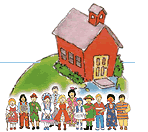|
Networked Projects incorporate many
features of traditional Project-Based Learning
(PBL), but they also include participation of
people outside the traditional classroom. In a
typical networked project, students in separate
locations conduct activities that require the
exchange of information. They may research,
experiment in their own settings, question expert
adults, and learn from one another. Participants
usually communicate via e-mail, an accessible and
almost ubiquitous resource, which also means many
of these activities are accessible to an
increasing number of classes, since the
"bandwidth" requirements are low. Itís
the Audience
Most teachers report that students are
interested and eager participants in these
projects. Student interest in learning and
adopting traditional literacy skills will renew,
because e-mail requires them. These projects
create a variety of opportunities for students to
practice and apply other skills and complex
learning strategies.
The power of these projects comes from
connecting your students with a real audience,
giving an authentic flavor students embrace. This
insight was expressed in the process-writing
movement by authors such as Donald Graves, Lucy
Calkins, and Donald Murray, who taught:
Students will write when they have a
sympathetic, interested audience and
they
have something to say.
In a landmark 1989 article*, telecomputing
pioneers Margaret Riel and Moshe Cohen reported
that when students write for a distant audience of
their peers,
- they are more fluent
- they are better organized
- their ideas are more clearly stated and
supported
- their content is more substantial and their
thesis is better supported
- they consider the needs of their
audience
* Cohen, Moshe, and Margaret Riel, "The
Effect of Distant Audiences on Studentsí
Writing," AERA Journal, Summer 1989, pp.
132-159
Over the years many teachers have reported that
when students use telecommunications to engage
with real people in another location, they enjoy
writing more; are more willing to write,
proofread, revise, and edit their work; and are
more careful about their spelling, punctuation,
grammar, and vocabulary. Combine student projects,
Web publishing, and the communications power of
the Internet, and teaching is transformed:
Classroom walls will tumble down. Students
interact with real people in the real world using
methods and tools people have used for years.
Learning becomes authentic and purposeful.
Students find new meaning in classroom
experiences. You and your students will rediscover
and share an excitement to
learn. Simple Technology
Sophisticated networked projects can be
conducted with fairly simple tools. Many powerful
projects in the past ten years have been managed
with nothing more than the tools listed here.
- Computer
- Modem
- E-mail
- Printer
In networked projects your students share and
exchange knowledge, research, and/or information
with experts and other students in distant
locations.
You will learn alongside your students, using
resources outside your classroom, school, library,
city, state, and country. Your students will also
become teachers as they contribute and help to
create learning resources for students, teachers,
experts, and others around the world.
The remainder of this section helps you locate,
choose, and participate in a basic networked
project.
| Join
the NetPBL Discussion Board
|
Subscribe to the NetPBL Mailing
List |
 |
 | |
